How blind, numb and unconcerned one has to be?

Every year it is reported that plastic waste pollutes our environment. The dimensions steadily increase and hazardous substances like brominated flame retardants are now a firm component of our daily food.
But there is one law of nature we cannot escape: “Who does not adapt, will die out!”
That applies also for a “Free Market Economy”:
Published in April 2008 by Gerald Altnau -> Nothing has changed!
We have decided to no longer updated this article, because the majority of our society is obviously not of the opinion that this is of interest or frightening.The effort would be too big. It would be difficult to keep up with horrific news and it would only create sadness. As long as the regulatory framework will not change, the situation will not improve and remain as described.
“Through me is the way among the lost people”
Inscription on the Gate to the Hell in Dante’s ‘Divine Comedy’
When first contemplating this subject, the picture of a tiny robot spontaneously came to mind: standing on a huge mountain of plastic waste, it had been constructed for the autonomous sorting of waste at a collection centre. Although its designers are long since dead (the planet has since become so polluted and overrun by un-recycled waste, that it can no longer support life), the solar-powered robot continues with its (in the meantime) irrelevant task.
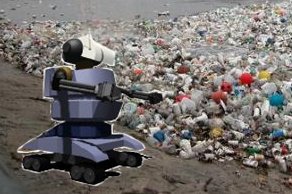
Thus it was with bitter irony that we discovered, a couple of weeks later, that this scenario had already been adapted by Walt Disney for its latest animated family movie ‘WALL-E’, which will run in theatres as from October 20081). Maybe this film will help prepare our children for the future they will face, and perhaps, using the plastic robots from the film’s merchandising campaign, and the waste packaging they find at home, they can re-enact the scene.

If one takes the European Union (EU) as an example of a more environmentally-conscious region, a recent APME Study2) shows that there are still 280 million tons of plastics in circulation emanating from the last 14 years (1993 to 2006) – and that is just the theory!
According to AMI 2007 European Plastics Industry Report3) approximately half of all thermoplastics are used in packaging, but we should not allow ourselves to be carried away by the naive assumption that European citizens store this plastic packaging at home
If one wants to find out where these huge plastic volumes have gone to, one should look elsewhere and think a bit more creatively.
1. How waste disappears or is buried
Germany is an environmentally conscious country with a very progressive waste-collection-sort & recycling system and corresponding legislation. It is also an ideal country to become rich through waste. According to wastecontrol4) we produce approximately 25 million tons of waste annually that is no longer allowed to be land-filled, but is incinerated in waste furnaces or sorted and pre-treated in so-called mechanical biological waste facilities. Approximately 40 billion Euros of turnover is achieved annually through waste, and experts estimate that approximately 7 million tons (nearly 1/3) are illegally land-filled in former mines and opencast pits in Germany. In their program, broadcast on 11 March 2008, ZDF Frontal 215) showed that this shredded home and industrial waste has a high plastic content. With this method ¾ of the cost can be saved; instead of 100 Euro per ton for incineration, waste disposal in a former clay pit costs only 40 Euro. The damage caused to the environment by illegal land-filling is tremendous, but the cost for containment and hazardous waste clean-up are paid by the tax-payers as a general rule.
RBB-online6) reported about crematories incinerating waste during cremations. It seems that in our society there is no limit to the desire for specialization and the aim for private wealth.

Waste handling fees in many places have increased because illegal waste-disposal has removed a potential source of fuel for incineration, and thus more oil is required in order to reach the necessary process temperatures.
Should we move away from “regulated” Germany, and look at the “pan-European” market, including Italy with its chaotic waste issues and the new East-European EU member states with their distant clay pits, land-fills and waste-furnaces (built with EU financial support), then new profitable business models arise, and one can easily imagine that also attractive plastic waste volumes will be moved through these channels.
2. The plastic food chain
Despite protective measures, the German bay belongs to the most waste polluted regions of the North Sea according to marine biologists at the University of Kiel7). More than 180 dead birds, collected along the German coastline have been examined during a study conducted since 2002, and nearly all (93%) had plastic waste in their stomach. Statistically 29 parts per animal were detected, 26 of them were “consumer plastics”. For years the “Association for Nature Conversation and Research“ (Naturschutz und Forschungsgemeinschaft) has captured the waste being washed up at the seafront at the Mellum and Minsener Oog. Analysis for the period 1991 until 2002 shows that on average nearly 80% of the collected waste consisted of plastic, Styropor® or foamed rubber – in total more than 25,600 pieces. According to expert statements, plastic waste still constitutes the major share and has not decreased as desired.

In their “Save the North Sea” Fulmar Study 2002-20048), the Dutch research institute Alterra performed autopsies on 600 dead fulmars, which had been washed up at the seafront of the North Sea: 95% had eaten indigestible waste, on average 44 pieces per animal.
Already in 2004 the environmental journalist Stephen Leahy9) described in an article for Oceana (the largest international Ocean Protection & Restoration Environmental advocacy group), that plastic bags, bottle tops and polystyrene foam coffee cups are often found in stomachs of dead sea lions, dolphins and sea turtles and he also quotes former U.N. Secretary General Kofi Anan, stating that it is mainly plastic that is killing more than a million seabirds and 100,000 mammals and sea turtles each year. For years Algalita Marine Research Foundation from California has reported the same problems10).
3. Plastic lids and floorings for our oceans
Tremendous masses of waste are discharged from ships, carried by rivers into the sea and carelessly littered at beaches. Oceana estimates that every hour, 675 tons of waste are directly disposed into the sea worldwide, half of which is plastics. Because not every plastic floats, it is assumed that 70% sinks to the ground. According to Greenpeace, Dutch scientists have counted approximately 110 pieces plastic waste per square kilometre sea bottom and calculated a total mass of 600,000 tons alone on the bottom of the North Sea13).
But who cares about 600,000 tons of plastic if, according to the WWF Report from June 200711), approximately 1.3 million tons of warfare agents are suspected on the bottom of the North Sea? In the end, the inhabitants of neighbouring states will pay for the clean-up with their taxes, or with their health.
The images are even more disturbing if one starts a global search for the 30% of floating plastic waste: In 1997 Captain Charles Moore made a shocking discovery in the Pacific Ocean when taking a short cut with his catamaran Alquita during a regatta between California and Hawaii. He ended up in a field of ‘swimming’ plastic that reached far beyond the horizon12).
1997 machte Kapitän Charles Moore eine schockierende Entdeckung im Pazifischen Ozean als er mit seinem Katamaran Alquita bei einer Regatta zwischen Kalifornien und Hawaii eine Abkürzung segeln wollte. Er landete in einem schwimmenden Plastikfeld, das weit über den Horizont reichte12).
Today, one decade later, this topic has even made its way into our media, and we now refer to that it is called the “Trash Vortex”13) - its size is estimated at 1,400,000 km2 (or approximately two times the size of Texas (695,600 km2) or four times the size of Germany (357.092 km2).
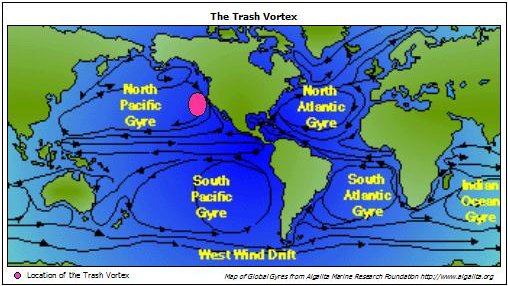
This mass is estimated at approximately 100 million tons15) and Markus Eriksen from the Agalita Marine Research Foundation (which was, by the way, founded by Captain Moore) describes its consistency as endless “plastic soup”. A fifth of this soup, consisting of everything from balls to kayaks to lego-building blocks and plastic bags, has been dumped from ships or oil-platforms, the rest has come from land.
In the meantime one kilogram of plankton competes with six kilograms of plastic at the surface14). Further vortexes are suspected in the South Pacific (e.g. in front of Japan), in the Atlantic Ocean and in the Indian Ocean10) with slightly lower masses, although their exact locations are not known. The plastic soup cannot be seen on satellite photos, because it is translucent.
For three years, the organisation "Green Ocean" has been studying the increase of plastic waste in the Mediterranean Sea where the distance between two plastic parts at the surface has shrunken to 80 cm. Floating plastic waste to a depth of 100 metres was documented and large fields of plastics were detected at the bottom of the sea with the help of under-water-cameras and sonar. The environmental pollution of the Mediterranean Sea was calculated at approximately 200 billion tons of plastic waste23).
The UN Environmental Program estimated in 2006, that 90% of the floating waste in the oceans consists of plastic and that each square mile contains approximately 46,000 floating plastic parts.
And if one is able to detect them, the immediate, pertinent questions are: “Who is responsible? Who will clean-up the soup? What do we do with it and who will pay for it?”
Experience has shown that such problems are only taken care of by engaged environmentalists, who have to finance themselves through donations, while at the same time the plastic producing industry complains about too-low profit margins and consolidation.
Or perhaps events with public participation are arranged, such as the “Clean-up” weekend in September 2006, when thousands of volunteers from 13 countries across the Mediterranean Sea – including scout groups in Algeria – cleaned up beaches as part of the UN Mediterranean Action Plans21). According to the UN organizers, one weekend will not be enough, because a plastic bag will need 150 years to degrade by solar radiation in the sea.
Until now nobody has found the easy solution. Oceans are too large and the problem is too big.
To add insult to injury, scientists have found out in the meantime that plastics do not only contain toxic additives, but, like a sponge, they can also absorb chemicals such as hydrocarbons or pesticides such as DDT10).
At this point, one has to ask the terrifying question: “How many million of tons of plastic waste are actually lying on the bottom of the oceans?”, when one has to take into account that only 30% float at the surface.
Expert opinion and common sense suggests that everything that finds its way into the oceans will also find its way out, e.g. via the food chain.
4. Comfortable beaches
In the sea, plastic parts are gradually finely ground to powder by solar radiation and wave motion. What happens to it is not very well understood, because plastic has been around for just 50 years and the magnitude of the problem has just become apparent.
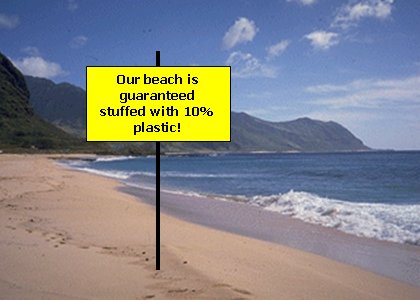
The biologist Richard Thompson and his team at the University of Plymouth14) study samples of sand and determine fragments up to a minimal size of 20 micro meter (smaller than the diameter of human hair) or so-called pellets (lost plastic granulates during transport), which are poetically called “mermaid’s tears”17). One can only hope that this is not 2nd grade recycled plastic that did not find its way to Asia. Thompson began his studies in 2004 with the examination of 18 British beaches and could prove that lugworms, barnacles and common amphipods eat these plastic parts. If the powder is fine enough it will be even taken up by plankton and can move up the food chain. The sand of the beach of Plymouth consists of 5-10% plastic according to Thompson.

In the meantime Thompson examined 25 additional beaches around the globe with similar results.
Geo-chemist Hideshige Takada from Tokyo University analyzed plastic pellets in the bay of Tokyo, and found that they absorb toxic and carcinogenic chemicals such as DDT and polychlorinated biphenyls.
It is practically impossible to clean-up beaches from plastic powders or granulates, because one can hardly sieve them all. Consequently one can only wait and see what happens to our food-chain, because, as a general rule, we are only convinced to act when it is already too late. The plastics in the oceans and at the beaches will still be there in many hundred years from now18). And the ratio is likely to increase rather than decrease.
5. “Second-hand” computers and cell phones for developing countries
According to Greenpeace, thousands of tons of toxic electronic waste from Europe and USA are – often illegally – shipped to Ghana30).
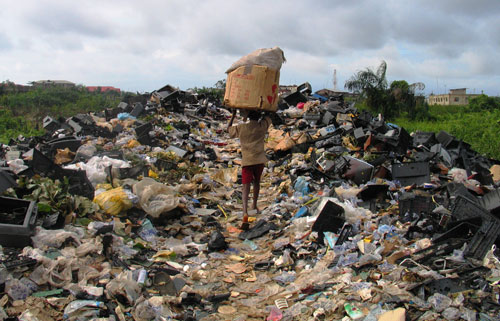
Defect computers and TVs from well-known brands are delivered in containers under the false label of “second-hand goods” from Germany, Korea, Switzerland and Netherlands to Ghana, and contain toxic chemicals such as lead, mercury and brominated flame retardants. Exporting e-waste from Europe is illegal but exporting old electronics for re-use allows creative traders to profit from dumping waste. In Ghana unprotected workers, many of them children, dismantle computers and TVs in search of metals that can be sold. The remaining plastic, cables and casings are either burnt or simply dumped and samples of the soil contained toxic metals, phtalates (softeners) and chlorinated dioxins. Many of the chemicals found are highly toxic and can affect brain development and the nervous system or promote cancer. Similar findings have already been made in China, India and Nigeria. The situation at such “Recycling Yards” has been impressively recorded in the photo gallery of the Basel Action Network (BAN)24).
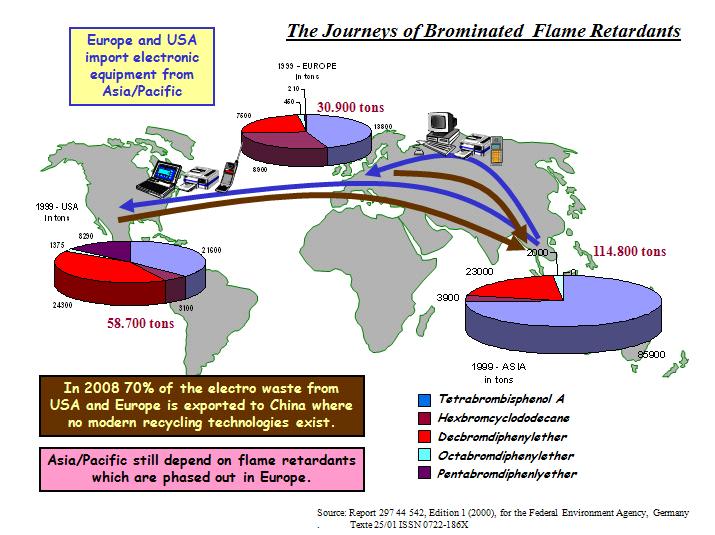
Traditional desk top computers with big monitors can contain as much as 1-3 kg of copper making it worth to recover (the question is only: How?)28) and for Elizabeth Grossman, an environmental journalist plastics present a much greater recycling challenge than metals as there are so many different plastics used in electronics29).

According to Science Daily already 70% of all computers, TVs, cell phones and other electronic waste are exported to China for recycling25).
The study “Body Loadings and Health Risk Assessment of Polychlorinated Dibenzo-p-dioxins and Dibenzofurans at an Intensive Electronic Waste Recycling Site in China”26) describes the recycling technologies which range from melting circuit boards over coal grills to cooking computer casings to remove combustible plastics in order to isolate metals and studies dioxin levels among women at child-bearing age. The annual volume of dismantled E-waste has exceeded 2.2 million metric tons and approximately 40.000 people are working alone in Taizhou to separate the metals.
Waste handling companies from the leading industrial nations probably fulfil a very important value-adding role today by bringing technological progress to developing countries in form of used electronics with the aim to advance them in their ability to recycle electronic waste so that they can gain a competitive edge to better compete with us on the world market.
The draft law on the management of electronic waste, aiming to reduce the pollution it causes, as approved by China’s cabinet on Wednesday August 20, 200827), could indeed have an adverse effect this value creation and one could be curious as to what governments of the large E-waste exporting countries will do in order to protect their waste collectors from this restriction on free global trade.
6. Tragedy of the Commons
Historically a common is a piece of land only locals have access to and can exercise a bundle of certain traditional rights. This is for example municipal property, like a forest, water from a pond for fire-fighting or a pasture for all parishioners with rights for grazing. The American microbiologist and ecologist Garret James Hardin (* 21 April 1915; † 14 September 2003) developed his theory in 1968 in an essay with the title “The Tragedy of the Commons” for the journal Science19).
The “Tragedy of the Commons” is an unavoidable destiny for mankind, for which a technical solution does not exist. Hardin’s thinking was stimulated by the issue of human overpopulation and its consequences.
Free access and unrestricted demand for a finite resource (common good) ultimately structurally dooms the resource through over-exploitation, because everybody will try to maximize his own yield (profit). It would only work if just a limited number of people could access a resource (e.g. land for herders for grazing) so that it is not exhausted. In the moment when the number of users exceeds a certain level, it will trigger the “Tragedy of the Commons”: Everybody will still continue to maximize his/her profit, but the good does not suffice any longer for everybody. The cost for this overexploitation (a robber economy) will be paid by society. For the individual, short-term profit is by far higher than the long-term cost, but in the end everybody contributes to the individual and municipal bankruptcy according to Hardin’s conclusion.
Oceans suffer from unscrupulous over-fishing because the fisherman only profits when the fish is in his own boat. It makes no sense to him to leave some fish in the sea to be caught by his competitors. The size of the catch defines his own success and revenue, when all fishermen will suffer from increasing cost e.g. shrinking shoals of fish.
If one now applies this concept to oceans, beaches, land-fills and waste (everybody has it and wants to get rid of it) and combines it with illegal behaviour and a sufficient portion of lack of sense for what is right or wrong, then one creates the right scenario for the tragedy described above. It even becomes tied in with the role of the authorities
- in industrialized countries, which issue reasonable regulations and laws, but are not able to execute and control adherence because of lacking budgets and/or personnel
- or in certain countries, where such regulations and laws are getting in the way of the desire for more industrialization and one’s own prosperity.
Right in the middle we have global companies which will move to the region where production cost and statutory hurdles are the lowest and profits are the highest.
7. Conclusion
CreaCycle GmbH was founded in 2002, in order to develop recycling processes in cooperation with the Fraunhofer Institut IVV, which allow the re-use of the recaptured plastics in their former applications, and the removal of additives and their dangerous degradation products.
In July 2005 the EPS-Loop Project was successfully concluded and it was proven that EPS recycling is technically and economically feasible. Up to today, interest in such a process has been limited, and we have assumed that we may be too early for a market that is not yet ready.
But if one recognises the afore-mentioned disaster scenario, it becomes obvious that we may be too late and the “Tragedy of the Commons” will prevent society and industry from doing the right thing:
- As long as one can make more profit with illegal waste-handling we will not be able to control certain flows of resources –> Striving for more property and wealth
- As long as authorities are not in a position to enforce adherence to existing laws there will be no incentive to follow those -> The common good "environment" is wilfully destroyed and there is no functional system in place to stop a robber economy or make it unattractive through repression.
- As long as we allow or stimulate export of plastic waste to other regions we give away control about what will happen to it. -> But the responsibility still remains with us, especially when we knowingly move the waste to countries with lower control and obligations than in our own ones and which do not have the necessary recycling technologies. By doing so we apply a robber economy to other societies, which of course live with us on the same Earth and breathe the same air.
One can only be astonished that information about severe environmental pollution requires 10 years before it is picked up by our media.
It is even more important to realize that plastic, despite having only been in use for approximately 50 years (because it has such good properties and is so cheap!), has already severely and irreversibly contaminated our oceans and beaches. Solutions to resolve this issue are at present unknown. We cannot even imagine what we are still to be confronted with in our food chain, but we do know that more plastics and their additives will come from the sea to us onto the land. And this will continue for many hundreds of years - even if we were to stop production of plastic tomorrow, or if we were to responsibly manage our waste streams.
It is high time to do something!!
It must sound strange for most Europeans when they hear that African states have already restricted the use of plastic (South Africa - May 2003; Eritrea, Rwanda, and Somalia – 2005; Tanzania and Zanzibar – 2006; Kenya and Uganda - Mid 2007), while Italy and France have only planned this for 2010. Since the Republic of Ireland passed a law in 2002 charging shoppers for each plastic carrier bag, their use has plummeted by 90%. In Germany plastic bags are still available free of charge in certain supermarkets. In the US, San Francisco became the first city to ban plastic bags from large supermarkets and pharmacies in March 2007. Several months later the rest of California passed laws requiring large supermarkets to take back and recycle plastic bags. China’s announcement (with a daily consumption of 3 billion plastic bags) to ban shops from handing out free plastic bags as from June 2008 and make production of ultra-thin carriers illegal already led to the closure of China’s largest plastic bag factory, in central Henan province22).
On the other hand, we continue to produce more and more mobile phones, computers and electronic devices, which we constantly seek to upgrade as technology improves faster and faster, in our quest to become contactable everywhere and always up-to-date. For such progress we need new recycling technologies. if we don’t want to end up eating our own plastic waste.
If we don’t act today, we should not be surprised if the story about the little robot as the last resident on Earth becomes true. Also the Science Fiction movie “Soylent Green” 20), released in 1973, seems today to be too close to reality for comfort in how it describes the issues of excessive use of resources, environmental pollution, global warming and over-population.

If, one day in the future, aliens do visit Earth after we have gone and perform an archaeological excavation, they may come to the following conclusion: that our culture may have been very developed, but, surprisingly, we eventually died out because we gave the same significance to the disposal of our waste as we did to members of our society. How else can one explain the numerous burials at sea and soil and cremation of our waste
Literature
- „WALL-E – der Letzte räumt die Erde auf“ Walt Disney Zeichentrickfilmim, Start Oktober 2008. - Link
- APME – „The compelling facts about plastics“ published January 2008 - PDF
- Auszüge aus AMI 2007 European Plastics Industry Report, erschienen im CHEManager 5/2008, Dr. W. Wunderlich „Erfolge im globalen Wettbewerb“, PDF
- Wastecontrol (Initiative gegen illegale Abfallentsorgung – PDF ) Hintergrund Information
- ZDF Frontal 21, Sendung vom 11. März 2008 – Müll in Sachsen-Anhalt illegal entsorgt. - PDF
- RBB-online vom 26. Februar 2008 – „Verdacht: Müllverbrennung in Särgen“ - PDF
- FR-online vom 13. März 2008 „Wenn die Möwen Plastik futtern“ - PDF
- „Save the North Sea“ Fulmar Study 2002-2004 - PDF
- Stephen Leahy, wired news for Culture Change , June 5, 2004 „Drowning in an ocean of plastic" - PDF
- Algalita Marine Research Foundation – current projects - Link
- 06 WWF-Meeresbericht “Geplündert, verschmutzt und zerstört” - Link
- The Sydney Morning Herald December 29, 2007 “The plastic killing fields” - Link
- 2007 Greenpeace international “The trash vortex” - Link
- Der Spiegel 6/2008 vom 2. Februar 2008 „Das Müllkarussel“ - Link
- The Independent 5 February 2008, Kathy Marks: The world rubbish dump: a garbage tip that stretches from Hawaii to Japan - Link
- The Daily Galaxy, 31 December 2007, „Are there really continents of floating garbage?“ Link
- BBC December 7, 2006: Plastics poisoning world’s seas - Link
- Pacific Northwest April 23, 2006, Paula Bock: Oceans of waste - Link
- Tragedy of the Commons – Wikipedia - Link
- Jahr 2022... die überleben wollen (Soylent Green) aus dem Jahr 1973 - Link
- BBC News 13 September 2006 „Mediterranean a dumping ground“- Link
- BBC News, 28 February 2008 „Plastic bag bans around the world“ - Link
- Plastic from the Sea "Plastik aus dem Meer" - File
- Basel Action Network (BAN) – Photo Gallery - Link
- Science Daily – Recycling of E-waste in China may expose mothers, infants to high dioxin levels - Link
- Ming H. Wong et al. “Body Loadings and Health Risk Assessment of Polychlorinated Dibenzo-p-dioxins and Dibenzofurans at an Intensive Electronic Waste Recycling Site in China”; Environ. Technol. 2007, 41, 7669 – 7674 - Link
- China Daily 2008-08-21 “China to regulate recycling of electronic waste” - Link
- Elizabeth Grossman – “Where computers go to die – and kill”, 10 April 2006 - File
- Green Diary June 1, 2007 – Elizabeth Grossman, an environmental journalist, explores the entire life cycle of high tech electronics - File
- Greenpeace 21 February 2008 - "Where does all the e-waste go?" - Link

